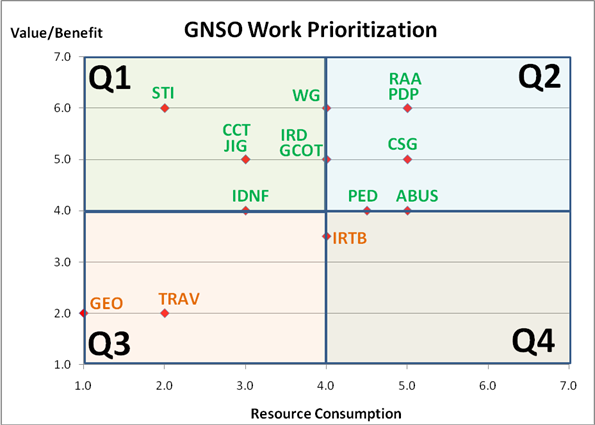[gnso-wpm-dt] WPM-DT: Step 3a (COMPLETED) -- Group DELPHI Results
- To: <gnso-wpm-dt@xxxxxxxxx>
- Subject: [gnso-wpm-dt] WPM-DT: Step 3a (COMPLETED) -- Group DELPHI Results
- From: "Ken Bour" <ken.bour@xxxxxxxxxxx>
- Date: Mon, 28 Dec 2009 15:32:44 -0500
WPM-DT Members:
We had another successful call today, 28 December, with participation by
Olga, Jaime, Chuck, Wolf and supported by Liz, Glen, Ken from Staff. This
email will summarize only the technical results of the call in which Step 3a
was completed. A second email will outline next steps and remaining issues
that came out of today's discussion.
The call went about 105 minutes in total length (scheduled for 90 minutes);
however, the time spent on ratings was approximately 70 minutes. In that
time, we managed to settle on Resource Consumption (X axis) values for all
11 Projects (4 previously had DELPHI scores) or about 7 minutes each - very
close to the previous session (21 December) in which Values/Benefits (Y
axis) were rated.
Please see my earlier email (Subject "Summary of Group Rating Session 21 Dec
2009") for a discussion of the methodology, which was similar this time with
one minor exception. We turned off the Adobe Connect "Broadcast Poll
Results" feature until after all participants had completed voting; then,
the results were shared publicly. As the facilitator, I believe that
change was a slight process improvement in that participants would not wait
to see how others might vote before registering their own rating. Even
with blind voting, there was a great deal of consensus after just one round
of discussion/polling. In addition, the team decided that, as long as the
Rating Range (High-Low score) was less than or equal to 2, the median result
would be computed and accepted. If the Rating Range > 2, then another
round would be attempted. For only one Project (RAA) did the group require
a second DELPHI discussion period and polling before achieving sufficient
commonality.
The matrix below shows the results of the team's efforts: black numbers are
the DELPHI results based upon group discussion while green/orange were
pre-decided based upon commonality of the Individual ratings.
X VALUES = RESOURCE CONSUMPTION
SEQ NO
SVG
WUK
CG
JW
OC
LG
DELPHI
STI
7
5
1
6
2
7
2.0
IDNF
3
4
3
3
4
3
3.0
GEO
3
2
1
4
1
2
1.0
TRAV
4
2
2
4
1
1
2.0
PED
5
4
3
5
4
5
4.5
ABUS
5
5
5
5
4
5
5.0
JIG
6
4
2
5
3
3
3.0
PDP
5
5
5
6
5
7
5.0
WG
5
2
3
5
4
5
4.0
GCOT
5
2
3
5
3
5
4.0
CSG
5
3
4
5
5
7
5.0
CCT
5
3
2
6
3
4
3.0
IRTB
5
4
2
4
3
5
4.0
RAA
6
5
3
6
4
7
5.0
IRD
2
3
3
3
3
6
4.0
Now that we have both X and Y values completed using the DELPHI approach,
the chart below depicts the new plotting of the 15 Projects:
Note 1: CCT/JIG (3.0, 5.0); IRD/GCOT (4.0, 5.0); and RAA/PDP (5.0, 6.0)
share common X,Y coordinates.
Note 2: The correlation statistic between X, Y from both DELPHI sessions is
52%.
The above chart can be compared to the two earlier versions (Means, Medians)
that were based upon Individual ratings (see Summary Tab of the attached
spreadsheet - now KBv2). Depending upon which comparison is made, Means
vs. Medians, the DELPHI results are relatively close with one or two
exceptions: STI moved from Q2 to Q1 and IDNF went from Q3 to Q1 (although
it is on the border). While the spread of the plotted points is wider in
the DELPHI results (esp. compared to the Individual Means), there were very
few substantive changes in positioning - just some jockeying around within
the quadrants. We continue not to have a project evaluated in Quadrant 4
(High Consumption and Low Value).
With these results, Step 3a has been completed as originally outlined.
Furthermore, Step 4 is now done, which was written as: "Develop the results
matrix/chart based on the rankings/ratings produced in Step 3." After
today's work, the team agreed to proceed on to Step 5, "Team assessment of
the construct and process/methodology and recommendations." It is possible
that, after our next meeting, a decision could be made to go back to Step 3
and try another combination, that is, there is team member interest in
attempting small groups of 2-3. If that is the final decision, we will
repeat Steps 4 and 5 for that iteration before moving to Step 6 "Focus on
HOW the team might utilize the data in terms of developing a prioritization
-- the ultimate goal of this effort."
Another email will outline next steps as well as a few issues that were
uncovered during today's session that require additional team discussion and
analysis.
Ken Bour
Attachment:
GNSO Work Prioritization-TEST RESULTS (KBv2).xls
Description: MS-Excel spreadsheet
- Follow-Ups:
- RE: [gnso-wpm-dt] WPM-DT: Step 3a (COMPLETED) -- Group DELPHI Results
- From: Gomes, Chuck
- RE: [gnso-wpm-dt] WPM-DT: Step 3a (COMPLETED) -- Group DELPHI Results
